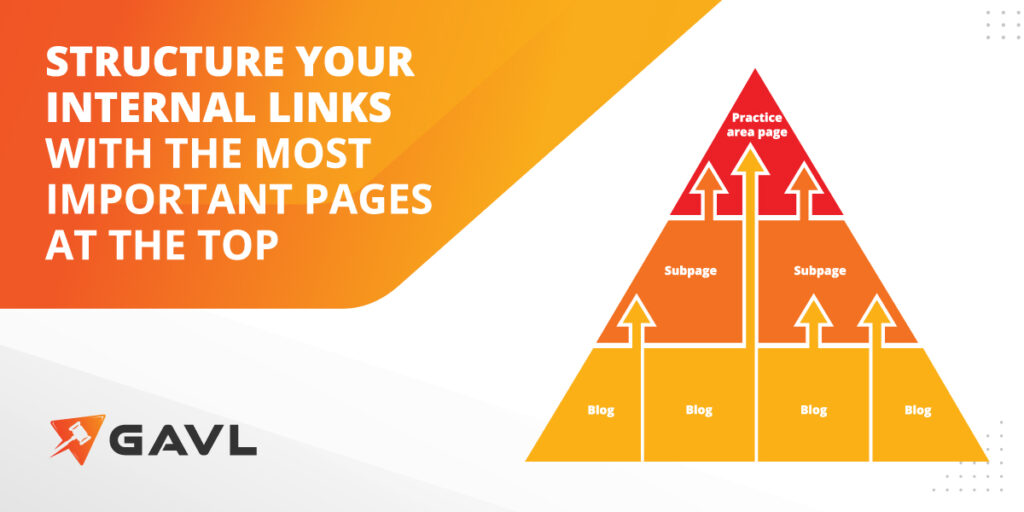Why Your Law Firm’s Internal Backlinks Matter
Getting quality backlinks from reputable websites is one of the most important ranking factors for SEO. But what about your website’s internal linking structure? Let’s get into why your law firm’s internal backlinks matter and three changes you can make today.
In this blog, I’ll answer questions like:
- What are internal links?
- What role do internal links play in SEO?
- Does anchor text placement matter?
Internal Links: Creating a Road Map for Users and Google
The pages on your website only have a chance of appearing on Google’s search engine results page (SERP) if they’ve been indexed.
Before a page or website can be indexed, it has to be crawled first. This is a process by which Google bots (also called “spiders”) discover new and updated pages. The spiders will travel through your website page by page and post by post, following internal links.
An internal link is a link that leads from one page of your website to another. This keeps visitors on your website instead of sending them somewhere else.
Your internal links are the road map for Google’s spiders. They tell these bots how pages are related and what topics are relevant. The clearer and more concise you can make this road map by optimizing your internal linking structure, the better the bots will be able to crawl and index your website.
A well-structured internal linking architecture will also make things easier for your website visitors. And as a law firm, you already know that you’re helping people who are going through some of the most difficult periods of their lives. Don’t make your website one more thing they have to struggle with.
Optimizing Your Site Structure for Internal Linking
How does Google know which pages are most important? Ideally, your site structure should make it clear. Although there are different types of site structures, the ideal structure for most law firms is the pyramid, with the homepage at the top.
Let’s visualize your website structure:
Depending on the size and competitiveness of your market, your site may or may not benefit from subpages under your main practice area pages.
With this linking structure, you can see the methodical way that each level supports your goal of showing up where your clients need you most—on the SERP.
Here are 3 steps you can take today to begin improving the internal linking structure of your own website:
- Identify your most important pages that are highest up on the pyramid.
- Create helpful and unique blogs that are related to the content on your most important pages. From each blog, link back to the most relevant page or subpage.
- Cut down on unnecessary links by limiting the number of practice area pages you link to on each blog. Don’t link to other pages or blogs unless you have a good reason to do so.
Passing Authority with Relevant Internal Links
Page authority (PA) is a critical ranking factor. Pages with high authority not only tend to rank on the first page of Google more frequently, but they also tend to rank higher.
And you can share that authority between pages.
Let’s say you have a hyper-niche blog that is performing well. It consistently ranks in the first spot on Google for its query. Maybe it’s snagged the feature snippet and brings in steady traffic with a low bounce rate. And now you want some of that blog’s authority to be shared with the most relevant practice area page.
You can do it with internal linking.
Say your high-performing blog is about the busiest intersections in Tucson, and you’re a personal injury lawyer who handles motor vehicle accidents. Your Tucson Car Accident Lawyer page could use a little love, so you place a link to the practice area page from your blog using highly relevant anchor text. And with that one little move, you’ve effectively shared some “link juice” from your blog to your practice area page, passing on and sharing some of that PA it’s earned.
Anchor Placement and Its Impact on Internal Linking Efforts
Anchor text is the actual clickable text found in your hyperlink. It usually appears in a different color than the rest of the text. Here’s an example of a hyperlink to our marketing guide for personal injury lawyers.
The placement of your anchor text isn’t necessarily a ranking factor. Whether you pop your anchor into the middle of your content or in the footer of your page doesn’t really matter to Google. But it does matter to your readers.
Your internal linking structure isn’t just for Google. If you’re not creating people-first content for visitors, you’re not filling the primary function of your website. Even Google wants to see “helpful content created for people in the search results.”
Cater your content to your audience by making your anchor text easy to find. Placing the anchor that links to your practice area page in the first third of your content is good practice, but don’t feel glued to this strategy. After all, your anchor placement should be natural, never forced.
Cultivate a Strong Internal Linking Structure
Like with all things SEO, experimentation is key. So, now that you know why your law firm’s internal backlinks matter, don’t be afraid to get out there and try something new!
Come see us at these events.

OAJ Annual Convention 2024
GAVL is proudly exhibiting at the Ohio Association for Justice Annual Convention 2024.

Society of Women Trial Lawyers Annual Conference 2024
GAVL is excited to attend the Society of Women Trial Lawyers Annual Conference 2024!

Injury Board Pathfinder 2024
GAVL will be attending the Injury Board Pathfinder 2024 seminar!

